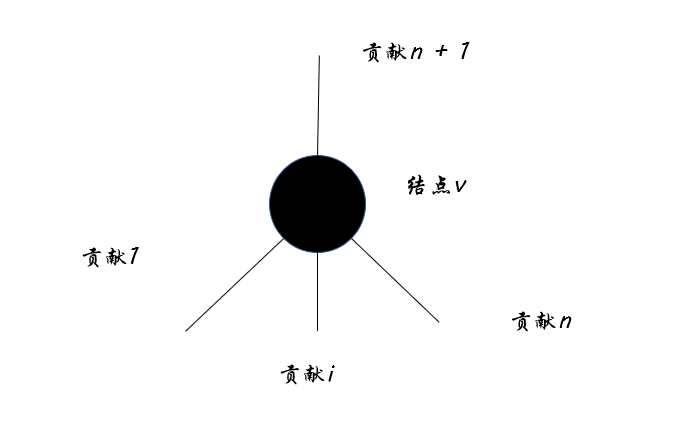CF1092 --- Tree with Maximum Cost
CF1092 --- Tree with Maximum Cost
题干
You are given a tree consisting exactly of \(n\) vertices. Tree is a connected undirected graph with \(n−1\) edges. Each vertex \(v\) of this tree has a value \(a_v\) assigned to it.
Let \(dist(x,y)\) be the distance between the vertices \(x\) and \(y\). The distance between the vertices is the number of edges on the simple path between them.
Let's define the cost of the tree as the following value: firstly, let's fix some vertex of the tree. Let it be \(v\). Then the cost of the tree is \(\sum\limits_{i=1}^{n}dist(i, v)a_i\)
Your task is to calculate the maximum possible cost of the tree if you can choose \(v\) arbitrarily.\(\mathcal{Input}\)
The first line contains one integer \(n\), the number of vertices in the tree \((1\leq n\leq 2⋅10^5)\).
The second line of the input contains \(n\) integers \(a_1,a_2, \cdots ,a_n \; (1\leq a_i\leq 2⋅10^5)\), where \(a_i\) is the value of the vertex \(i\).
Each of the next \(n−1\) lines describes an edge of the tree. Edge \(i\) is denoted by two integers \(u_i\) and \(v_i\), the labels of vertices it connects \((1\leq u_i,v_i\leq n, u_i\not= v_i).\)
It is guaranteed that the given edges form a tree.
\(\mathcal{Output}\)
Print one integer — the maximum possible cost of the tree if you can choose any vertex as \(v\).
\(\mathcal{Example}\)\(Case_1\)
\(Input\)
8
9 4 1 7 10 1 6 5
1 2
2 3
1 4
1 5
5 6
5 7
5 8
\(Output\)
121
\(Case_2\)
\(Input\)
1
1337
\(Output\)
0
\(\mathcal{Note}\)
Picture corresponding to the first example:
You can choose the vertex \(3\) as a root, then the answer will be \(2⋅9+1⋅4+0⋅1+3⋅7+3⋅10+4⋅1+4⋅6+4⋅5=18+4+0+21+30+4+24+20=121\).
In the second example tree consists only of one vertex so the answer is always \(0\).
\(\mathcal{Tag}\)
dfs and similardptree*1800
思路分析
本题要求解的是,对于树中所有结点,以该节点为根的情况下计算费用,并求费用的最大值。注意在结点非常多的情况下,要考虑\(int\)溢出的问题,故开\(long\;long\)(坑死我了)
暴力想法
暴力想法很简单,很类似CF1324 --- Maximum White Subtree,这里直接搬运那个题解里面的图片

对于任意结点,分别计算不同路径的位置,根据树数据结构的特点,可以把贡献分为:
- 上层父祖先节点贡献
- 下层子孙结点贡献
然后就是,如何把暴力\(dfs\),通过记忆化实现算法优化。
算法优化
我们先求解下层子孙结点的贡献,通过题目我们知道,从结点\(v\)转移到结点\(u\),其中增量的就是以\(v\)为根结点,其子树中所有结点值的和。其中\(a_i\)代表结点\(i\)的值,我们设\(f_i\)代表以\(i\)结点为子树根结点,该子树所有结点的和。我们设\(hp_i\)代表以\(i\)结点的下层子孙贡献值,这样我们可以写出下层子孙结点贡献值的转移表达值:
现在我们解决了下层得想办法解决更加困难的上层了,对于这类换根dp问题,常用的手段是用利用父节点的值进行状态转移。在这里我们设\(dp_i\)为结点\(i\)的最终费用。因此对于某一节点(非根结点),该节点的最终费用可以表示为:
上述表达式的意思为:父节点刨去结点\(cur\)的费用值(\(dp[fa] - hp[cur] - f[cur]\),加上增量(\(f[fa] - f[cur]\), note 这里的f[fa],代表着所有的结点和),再最后加上下层子孙结点贡献值(\(hp[cur]\)).
&emps;因此我们最终的思路还是为:
- 从下往上树形\(dp\),计算\(f_v\),\(hp_v\)
- 从上往下换根\(dp\),计算\(dp_v\)
代码
#include<bits/stdc++.h>
using namespace std;
using LL = long long;
using VL = vector<LL>;
using VVL = vector<VL>;
LL mx = 0x8000000000000000;
VL a, f, hp, dp;
VVL e;
void dfs(int x, int fa = -1)
{
f[x] = a[x], hp[x] = 0;
for (auto to : e[x])
{
if (to == fa) continue;
dfs(to, x);
f[x] += f[to];
hp[x] += (hp[to] + f[to]);
}
}
void rdfs(int x, int fa = -1)
{
dp[x] = hp[x];
mx = max(mx, dp[x]);
for (auto to : e[x])
{
if (to == fa) continue;
hp[to] = dp[x] + f[x] - 2*f[to];
f[to] = f[x];
rdfs(to, x);
}
}
int main()
{
int n;
cin >> n;
a = f = hp = dp = VL(n);
e = VVL(n);
for (auto &x : a) cin >> x;
for (int i = 0; i < n - 1; ++ i)
{
int x, y;
cin >> x >> y;
-- x, -- y;
e[x].push_back(y);
e[y].push_back(x);
}
dfs(0);
rdfs(0);
cout << mx << endl;
return 0;
}
做了两次了,这个1092是自己手打的,还是有进步。WA了一次是没有考虑到整数溢出的情况以后得多加考虑。
以后对于每个根结点都要求的题,考虑优先换根dp。


